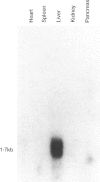Abstract
The serum lectin, mannan-binding lectin (MBL) (also denoted mannan-binding protein or mannose-binding protein, MBP) has been identified in mammals (humans, monkey, cow, rabbit, mouse and rat). Upon binding to carbohydrates on the surface of microorganisms, MBL mediates activation of the complement system, leading to killing of the microorganism. MBL thus exerts a role in the innate immune defence. We have described the isolation and partial characterization of an analogous protein in chicken serum. Oligonucleotides based on the N-terminal sequence of this protein were used in a reverse transcription-polymerase chain reaction (RT-PCR) with chicken liver RNA as template. The PCR product was sequenced and found to encode part of the NH2 terminus of chicken MBL. A perfect match probe was synthesized and used to screen a chicken liver cDNA library. The isolated clones carried a cDNA insert of 1692 bp with an open reading frame of 714 bp encoding a mature protein of 238 amino acids including a signal peptide of five amino acids. The deduced amino acid sequence agrees with those determined by conventional amino acid sequence analysis of the peptides except for four residues. We have compared the deduced primary structure of chicken MBL with the mammalian analogues. The phylogenetic analysis indicates that the gene duplication leading to two different MBL forms in mammals occurred after the split from birds and reptiles. This concurs with the finding of only one form of MBL in chickens.
Full text
PDF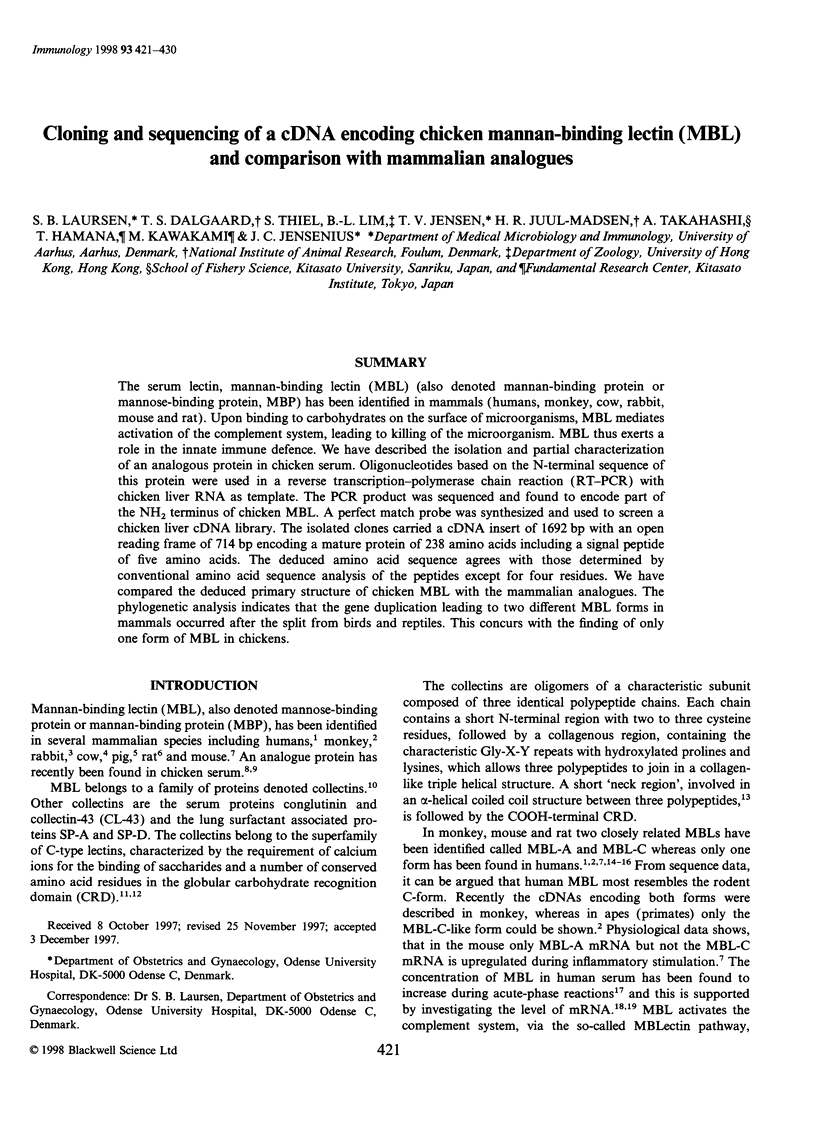
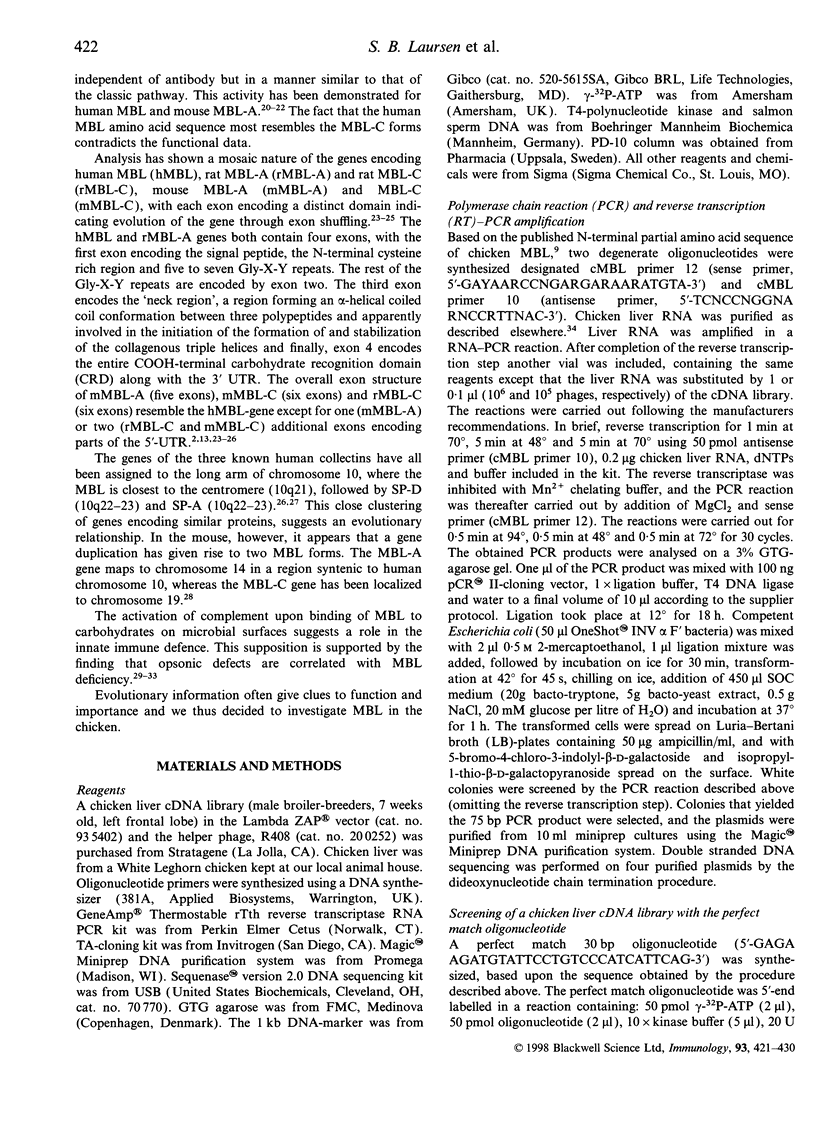

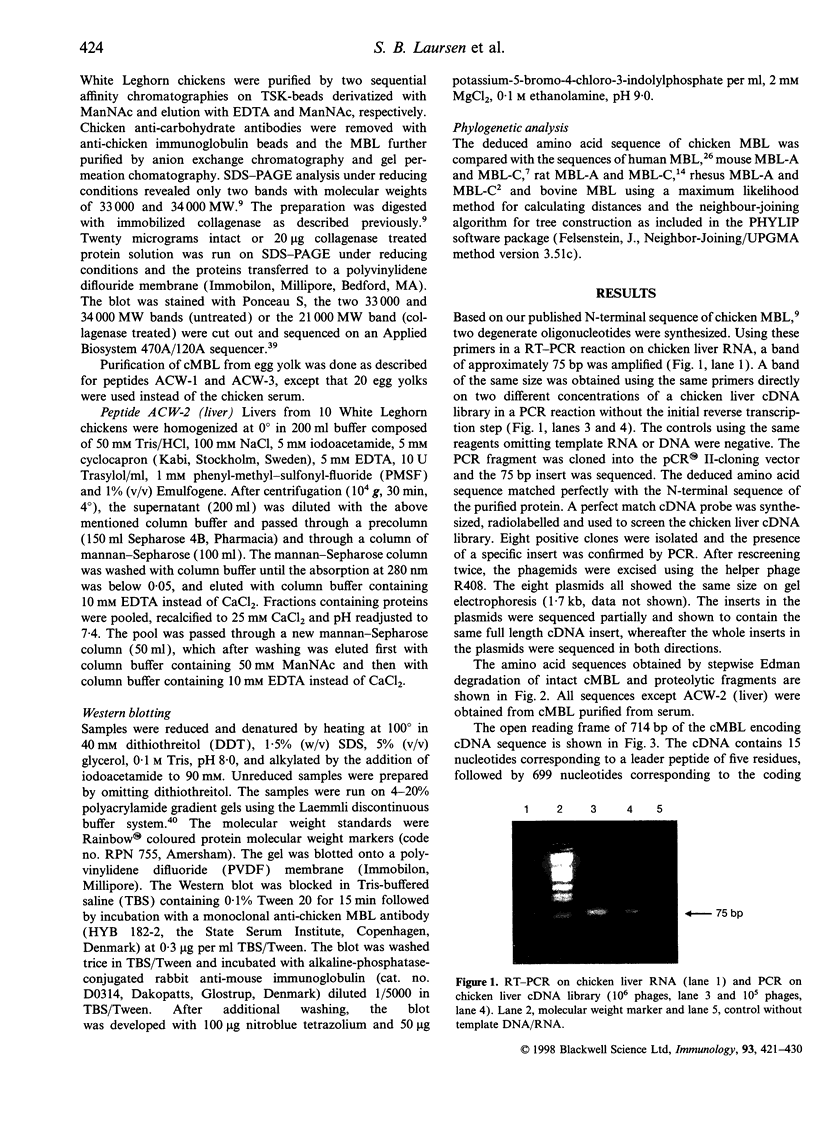
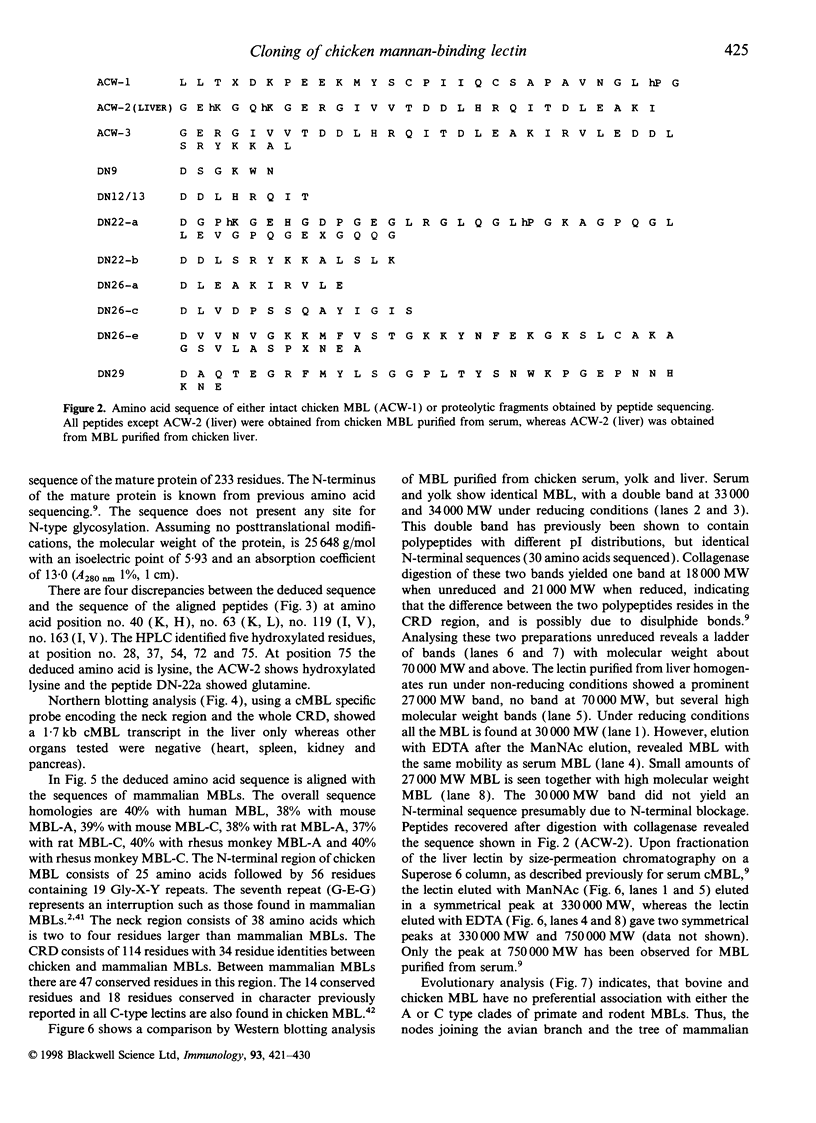

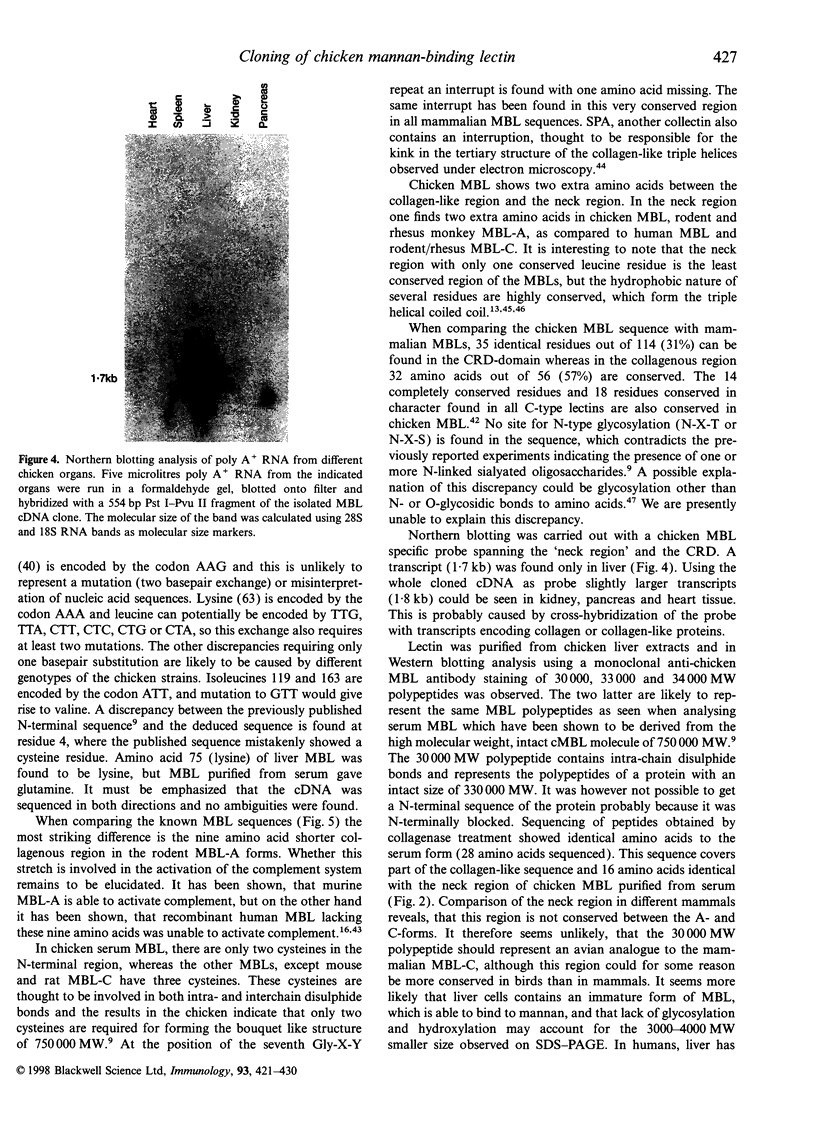


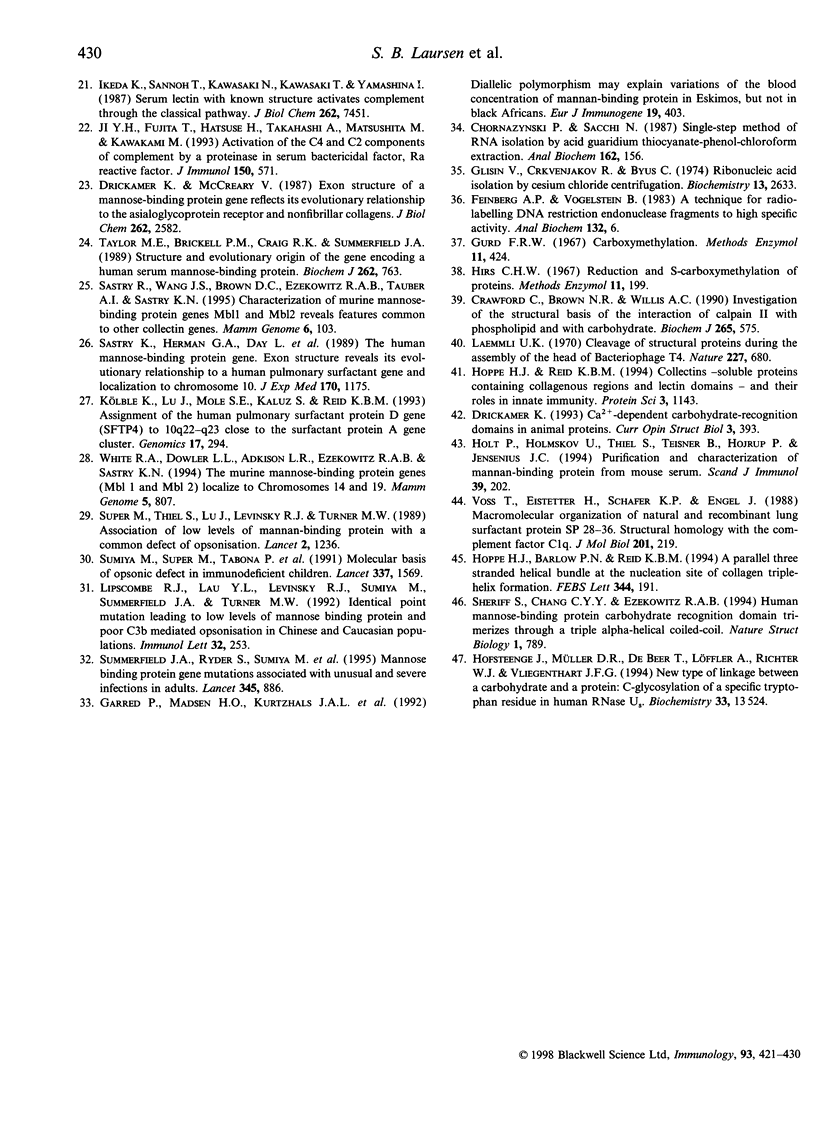
Images in this article
Selected References
These references are in PubMed. This may not be the complete list of references from this article.
- Arai T., Tabona P., Summerfield J. A. Human mannose-binding protein gene is regulated by interleukins, dexamethasone and heat shock. Q J Med. 1993 Sep;86(9):575–582. [PubMed] [Google Scholar]
- Chomczynski P., Sacchi N. Single-step method of RNA isolation by acid guanidinium thiocyanate-phenol-chloroform extraction. Anal Biochem. 1987 Apr;162(1):156–159. doi: 10.1006/abio.1987.9999. [DOI] [PubMed] [Google Scholar]
- Crawford C., Brown N. R., Willis A. C. Investigation of the structural basis of the interaction of calpain II with phospholipid and with carbohydrate. Biochem J. 1990 Jan 15;265(2):575–579. doi: 10.1042/bj2650575. [DOI] [PMC free article] [PubMed] [Google Scholar]
- Drickamer K., Dordal M. S., Reynolds L. Mannose-binding proteins isolated from rat liver contain carbohydrate-recognition domains linked to collagenous tails. Complete primary structures and homology with pulmonary surfactant apoprotein. J Biol Chem. 1986 May 25;261(15):6878–6887. [PubMed] [Google Scholar]
- Drickamer K., McCreary V. Exon structure of a mannose-binding protein gene reflects its evolutionary relationship to the asialoglycoprotein receptor and nonfibrillar collagens. J Biol Chem. 1987 Feb 25;262(6):2582–2589. [PubMed] [Google Scholar]
- Drickamer K. Two distinct classes of carbohydrate-recognition domains in animal lectins. J Biol Chem. 1988 Jul 15;263(20):9557–9560. [PubMed] [Google Scholar]
- Ezekowitz R. A., Day L. E., Herman G. A. A human mannose-binding protein is an acute-phase reactant that shares sequence homology with other vertebrate lectins. J Exp Med. 1988 Mar 1;167(3):1034–1046. doi: 10.1084/jem.167.3.1034. [DOI] [PMC free article] [PubMed] [Google Scholar]
- Feinberg A. P., Vogelstein B. A technique for radiolabeling DNA restriction endonuclease fragments to high specific activity. Anal Biochem. 1983 Jul 1;132(1):6–13. doi: 10.1016/0003-2697(83)90418-9. [DOI] [PubMed] [Google Scholar]
- Garred P., Madsen H. O., Kurtzhals J. A., Lamm L. U., Thiel S., Hey A. S., Svejgaard A. Diallelic polymorphism may explain variations of the blood concentration of mannan-binding protein in Eskimos, but not in black Africans. Eur J Immunogenet. 1992 Dec;19(6):403–412. doi: 10.1111/j.1744-313x.1992.tb00083.x. [DOI] [PubMed] [Google Scholar]
- Glisin V., Crkvenjakov R., Byus C. Ribonucleic acid isolated by cesium chloride centrifugation. Biochemistry. 1974 Jun 4;13(12):2633–2637. doi: 10.1021/bi00709a025. [DOI] [PubMed] [Google Scholar]
- Holmskov U., Holt P., Reid K. B., Willis A. C., Teisner B., Jensenius J. C. Purification and characterization of bovine mannan-binding protein. Glycobiology. 1993 Apr;3(2):147–153. doi: 10.1093/glycob/3.2.147. [DOI] [PubMed] [Google Scholar]
- Holt P., Holmskov U., Thiel S., Teisner B., Højrup P., Jensenius J. C. Purification and characterization of mannan-binding protein from mouse serum. Scand J Immunol. 1994 Feb;39(2):202–208. doi: 10.1111/j.1365-3083.1994.tb03361.x. [DOI] [PubMed] [Google Scholar]
- Hoppe H. J., Barlow P. N., Reid K. B. A parallel three stranded alpha-helical bundle at the nucleation site of collagen triple-helix formation. FEBS Lett. 1994 May 16;344(2-3):191–195. doi: 10.1016/0014-5793(94)00383-1. [DOI] [PubMed] [Google Scholar]
- Hoppe H. J., Reid K. B. Collectins--soluble proteins containing collagenous regions and lectin domains--and their roles in innate immunity. Protein Sci. 1994 Aug;3(8):1143–1158. doi: 10.1002/pro.5560030801. [DOI] [PMC free article] [PubMed] [Google Scholar]
- Ikeda K., Sannoh T., Kawasaki N., Kawasaki T., Yamashina I. Serum lectin with known structure activates complement through the classical pathway. J Biol Chem. 1987 Jun 5;262(16):7451–7454. [PubMed] [Google Scholar]
- Ji Y. H., Fujita T., Hatsuse H., Takahashi A., Matsushita M., Kawakami M. Activation of the C4 and C2 components of complement by a proteinase in serum bactericidal factor, Ra reactive factor. J Immunol. 1993 Jan 15;150(2):571–578. [PubMed] [Google Scholar]
- Kawasaki N., Kawasaki T., Yamashina I. Isolation and characterization of a mannan-binding protein from human serum. J Biochem. 1983 Sep;94(3):937–947. doi: 10.1093/oxfordjournals.jbchem.a134437. [DOI] [PubMed] [Google Scholar]
- Kozutsumi Y., Kawasaki T., Yamashina I. Isolation and characterization of a mannan-binding protein from rabbit serum. Biochem Biophys Res Commun. 1980 Jul 31;95(2):658–664. doi: 10.1016/0006-291x(80)90836-0. [DOI] [PubMed] [Google Scholar]
- Kurata H., Sannoh T., Kozutsumi Y., Yokota Y., Kawasaki T. Structure and function of mannan-binding proteins isolated from human liver and serum. J Biochem. 1994 Jun;115(6):1148–1154. doi: 10.1093/oxfordjournals.jbchem.a124471. [DOI] [PubMed] [Google Scholar]
- Kölble K., Lu J., Mole S. E., Kaluz S., Reid K. B. Assignment of the human pulmonary surfactant protein D gene (SFTP4) to 10q22-q23 close to the surfactant protein A gene cluster. Genomics. 1993 Aug;17(2):294–298. doi: 10.1006/geno.1993.1324. [DOI] [PubMed] [Google Scholar]
- Laemmli U. K. Cleavage of structural proteins during the assembly of the head of bacteriophage T4. Nature. 1970 Aug 15;227(5259):680–685. doi: 10.1038/227680a0. [DOI] [PubMed] [Google Scholar]
- Laursen S. B., Hedemand J. E., Thiel S., Willis A. C., Skriver E., Madsen P. S., Jensenius J. C. Collectin in a non-mammalian species: isolation and characterization of mannan-binding protein (MBP) from chicken serum. Glycobiology. 1995 Sep;5(6):553–561. doi: 10.1093/glycob/5.6.553. [DOI] [PubMed] [Google Scholar]
- Lipscombe R. J., Lau Y. L., Levinsky R. J., Sumiya M., Summerfield J. A., Turner M. W. Identical point mutation leading to low levels of mannose binding protein and poor C3b mediated opsonisation in Chinese and Caucasian populations. Immunol Lett. 1992 May;32(3):253–257. doi: 10.1016/0165-2478(92)90058-v. [DOI] [PubMed] [Google Scholar]
- Lu J. H., Thiel S., Wiedemann H., Timpl R., Reid K. B. Binding of the pentamer/hexamer forms of mannan-binding protein to zymosan activates the proenzyme C1r2C1s2 complex, of the classical pathway of complement, without involvement of C1q. J Immunol. 1990 Mar 15;144(6):2287–2294. [PubMed] [Google Scholar]
- Oka S., Ikeda K., Kawasaki T., Yamashina I. Isolation and characterization of two distinct mannan-binding proteins from rat serum. Arch Biochem Biophys. 1988 Jan;260(1):257–266. doi: 10.1016/0003-9861(88)90448-1. [DOI] [PubMed] [Google Scholar]
- Sastry K., Herman G. A., Day L., Deignan E., Bruns G., Morton C. C., Ezekowitz R. A. The human mannose-binding protein gene. Exon structure reveals its evolutionary relationship to a human pulmonary surfactant gene and localization to chromosome 10. J Exp Med. 1989 Oct 1;170(4):1175–1189. doi: 10.1084/jem.170.4.1175. [DOI] [PMC free article] [PubMed] [Google Scholar]
- Sastry K., Zahedi K., Lelias J. M., Whitehead A. S., Ezekowitz R. A. Molecular characterization of the mouse mannose-binding proteins. The mannose-binding protein A but not C is an acute phase reactant. J Immunol. 1991 Jul 15;147(2):692–697. [PubMed] [Google Scholar]
- Sastry R., Wang J. S., Brown D. C., Ezekowitz R. A., Tauber A. I., Sastry K. N. Characterization of murine mannose-binding protein genes Mbl1 and Mbl2 reveals features common to other collectin genes. Mamm Genome. 1995 Feb;6(2):103–110. doi: 10.1007/BF00303252. [DOI] [PubMed] [Google Scholar]
- Sheriff S., Chang C. Y., Ezekowitz R. A. Human mannose-binding protein carbohydrate recognition domain trimerizes through a triple alpha-helical coiled-coil. Nat Struct Biol. 1994 Nov;1(11):789–794. doi: 10.1038/nsb1194-789. [DOI] [PubMed] [Google Scholar]
- Storgaard P., Nielsen E. H., Andersen O., Skriver E., Mortensen H., Højrup P., Leslie G., Holmskow U., Svehag S. E. Isolation and characterization of porcine mannan-binding proteins of different size and ultrastructure. Scand J Immunol. 1996 Mar;43(3):289–296. doi: 10.1046/j.1365-3083.1996.d01-39.x. [DOI] [PubMed] [Google Scholar]
- Sugii S., Hirota Y. Identification and carbohydrate specificity of a chicken serum mannan-binding protein reactive with a Ra chemotype strain of Salmonella typhimurium. J Vet Med Sci. 1994 Aug;56(4):747–751. doi: 10.1292/jvms.56.747. [DOI] [PubMed] [Google Scholar]
- Sumiya M., Super M., Tabona P., Levinsky R. J., Arai T., Turner M. W., Summerfield J. A. Molecular basis of opsonic defect in immunodeficient children. Lancet. 1991 Jun 29;337(8757):1569–1570. doi: 10.1016/0140-6736(91)93263-9. [DOI] [PubMed] [Google Scholar]
- Summerfield J. A., Ryder S., Sumiya M., Thursz M., Gorchein A., Monteil M. A., Turner M. W. Mannose binding protein gene mutations associated with unusual and severe infections in adults. Lancet. 1995 Apr 8;345(8954):886–889. doi: 10.1016/s0140-6736(95)90009-8. [DOI] [PubMed] [Google Scholar]
- Super M., Thiel S., Lu J., Levinsky R. J., Turner M. W. Association of low levels of mannan-binding protein with a common defect of opsonisation. Lancet. 1989 Nov 25;2(8674):1236–1239. doi: 10.1016/s0140-6736(89)91849-7. [DOI] [PubMed] [Google Scholar]
- Taylor M. E., Brickell P. M., Craig R. K., Summerfield J. A. Structure and evolutionary origin of the gene encoding a human serum mannose-binding protein. Biochem J. 1989 Sep 15;262(3):763–771. doi: 10.1042/bj2620763. [DOI] [PMC free article] [PubMed] [Google Scholar]
- Thiel S., Holmskov U., Hviid L., Laursen S. B., Jensenius J. C. The concentration of the C-type lectin, mannan-binding protein, in human plasma increases during an acute phase response. Clin Exp Immunol. 1992 Oct;90(1):31–35. doi: 10.1111/j.1365-2249.1992.tb05827.x. [DOI] [PMC free article] [PubMed] [Google Scholar]
- Voss T., Eistetter H., Schäfer K. P., Engel J. Macromolecular organization of natural and recombinant lung surfactant protein SP 28-36. Structural homology with the complement factor C1q. J Mol Biol. 1988 May 5;201(1):219–227. doi: 10.1016/0022-2836(88)90448-2. [DOI] [PubMed] [Google Scholar]
- Weis W. I., Kahn R., Fourme R., Drickamer K., Hendrickson W. A. Structure of the calcium-dependent lectin domain from a rat mannose-binding protein determined by MAD phasing. Science. 1991 Dec 13;254(5038):1608–1615. doi: 10.1126/science.1721241. [DOI] [PubMed] [Google Scholar]
- White R. A., Dowler L. L., Adkison L. R., Ezekowitz R. A., Sastry K. N. The murine mannose-binding protein genes (Mbl 1 and Mbl 2) localize to chromosomes 14 and 19. Mamm Genome. 1994 Dec;5(12):807–809. doi: 10.1007/BF00292020. [DOI] [PubMed] [Google Scholar]
- Wild J., Robinson D., Winchester B. Isolation of mannose-binding proteins from human and rat liver. Biochem J. 1983 Jan 15;210(1):167–174. doi: 10.1042/bj2100167. [DOI] [PMC free article] [PubMed] [Google Scholar]




